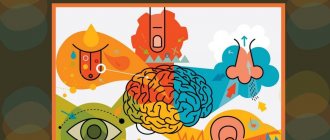How it works
Photo by Polina Kovaleva: Pexels
Sensations are a process that reflects the interaction of your physical body and psyche with the environment. Sensations arise through direct influence on the sense organs. As a result of this interaction, irritation of the receptors occurs.
A receptor is a sensitive nerve ending or specialized cell that converts perceived stimulation into nerve impulses. The impulses arrive at the analyzers, or as they are commonly called, sense organs. Each of the senses is responsible for recognizing its own class of stimuli.
There are five sense organs in the human body:
- sense of smell;
- taste;
- touch;
- vision;
- hearing.
Sensory adaptation and interaction of sensations
The change in sensitivity that occurs as a result of the adaptation of a sensory organ to the stimuli acting on it is called sensory adaptation. There are three modalities of sensory adaptation:
1. Complete disappearance of sensation during prolonged action of the stimulus. Examples of this include: adaptation to the smell of the olfactory analyzer in a person who has been working with odorous substances for a long time; auditory adaptation to constantly exposed noise, etc.
2. Dulling of sensation under the influence of a strong stimulus. For example, a temporary decrease in the sensitivity of the visual analyzer after a person moves from a dimly lit room to bright light conditions (light adaptation). This modality is called negative, as it leads to a decrease in the sensitivity of the analyzer.
Adaptation to light and darkness has a negative effect, especially in dim lighting conditions. Under these conditions, the reaction time of vehicle drivers increases, the localization of moving objects worsens, which often leads to emergency situations on the roads.
3. Increased sensitivity under the influence of a weak stimulus. For example, when a weak stimulus is applied to the auditory analyzer in conditions of complete silence (the auditory analyzer begins to detect rather weak sound stimuli - auditory adaptation).
This pattern should be taken into account in investigative (judicial) practice when assessing witness testimony. For example, it is known that complete adaptation to darkness occurs after 30–40 minutes. Sometimes an investigator may show unreasonable distrust of different testimonies of two witnesses to the same event. If one witness was fully adapted to the dark, and the other was in these conditions for only a few minutes, then the testimony of the latter will be inaccurate and incomplete. However, this should not be a reason for the investigator to show distrust of him.
All types of sensations are not isolated from each other, so their intensity depends not only on the strength of the stimulus and the level of adaptation of the receptor, but also on the stimuli currently affecting other sense organs. A change in the sensitivity of the analyzer under the influence of irritation of other senses is called the interaction of sensations (Fig. 7).
Interaction of sensations
Interaction between sensations of the same type. Thus, gray on a white background will look darker, and surrounded by black it will look lighter.
Interaction between sensations of different types. Thus, sound stimulation can sharpen the work of the visual analyzer, increasing its sensitivity to light stimuli
Increased sensitivity as a result of interaction between analyzers or exercise (sensitization)
The appearance, under the influence of irritation of one analyzer, of a sensation characteristic of other analyzers (synesthesia)
Rice. 7. Interaction of sensations
Sensitization (from Latin sensibilis - sensitive) is an increase in the sensitivity of analyzers under the influence of internal (mental) factors. Sensitization or exacerbation of sensitivity may be caused by:
- interaction of sensations (for example, weak taste sensations increase visual sensitivity). This is explained by the interconnection of analyzers, their systematic work;
- physiological factors (the state of the body, the introduction of certain substances into the body; for example, vitamin A is essential to increase visual sensitivity);
- the expectation of a particular influence, its significance, a special attitude towards distinguishing certain stimuli;
- exercise, experience (thus, tasters, by specially exercising their taste and olfactory sensitivity, distinguish between different types of wines and teas and can even determine when and where the product was made).
This mechanism of interaction of sensations can influence the quality of the investigative experiment, the completeness and objectivity of testimony. For example, it is known that visual sensitivity is significantly reduced when the olfactory receptor is exposed to an unpleasant odor. This circumstance must be taken into account when examining the scene of the incident, a corpse with significant cadaveric changes, and during exhumation. In such cases, in order to complete the entire volume of work at the proper level, the investigative team needs to take breaks from work.
In people deprived of any type of sensitivity, this deficiency is compensated (compensated) by increasing the sensitivity of other organs (for example, increasing auditory and olfactory sensitivity in the blind). This is the so-called compensatory sensitization.
Synesthesia (from the gr. synaisthesis - joint sensation) is an associative non-modal sensation that accompanies the real one. For example, some people, under the influence of sound stimuli, may experience vivid visual images, different taste sensations, etc.
When sensations interact, a phenomenon called contrast of sensations can occur. This occurs in cases where the same stimulus is perceived by the analyzer depending on the qualitative characteristics of another stimulus that acted on the same analyzer simultaneously or sequentially (for example, a sequential contrast of taste sensations). Contrasting phenomena often lead to errors in sensations, which, in turn, lead to errors in testimony. For example, witnesses to one crime stated that the perpetrator was wearing a white suit and was very tall; in reality, they saw a man of average height, wearing a gray suit against a black background. Knowledge of the patterns of sensations contributes to more qualified detection of crimes.
In the work of a lawyer, sensations form the basis of a more complex process of perceiving objects and phenomena; they are directly related to the performance of professional activities and have a significant impact on it.
Time of action
Sensations do not arise instantly; it takes a certain time for the impulse from the receptor, when exposed to a stimulus, to reach the analyzer or sensory organ. This time is called the latent or hidden period of sensation. The latent period for different sensations is different, for example, for tactile sensations - 130 ms, and for pain - 370 ms.
Concept, properties and types of sensations
The effect of sensations also does not stop immediately after the interaction with the stimulus stops. The time of inertial attenuation of sensations is called aftereffect. It is the aftereffect that allows you to watch films: the gaps between frames are filled with images of the previous frame.
Basic properties of sensations
Sensations have certain properties:
- quality determines the main feature of each sensation, and is the main distinguishing feature of each sensation;
- intensity determines the strength of the stimulus on the receptor, as well as the functional state of the receptor itself and its readiness to perceive the action of the stimulus. Intensity is a quantitative characteristic;
- duration determines the duration of the sensation. The duration is directly dependent on the functional state of the analyzer and the intensity of the stimulus;
- spatial location allows you to localize the stimulus in space, for example: you can determine which part of the body was affected by the stimulus upon contact.
Properties and phenomena
Sensitivity is the ability to reflect the influence of surrounding objects on the human body. And during the interaction of various sensations, some phenomena arise:
- adaptation;
- sensitization;
- synesthesia.
The first concept means a change in sensations due to constant exposure to a stimulus or regular training. During sensitization, when one analyzer is exposed to another, the sensitivity changes. And with synesthesia, sensations characteristic of one system are transferred to another complex.
Different types of sensations are distinguished by common properties:
- quality;
- intensity;
- spatial localization;
- duration.
The peculiarity of quality lies in the difference between one type of sensation and another. Hearing is characterized by the volume, pitch and timbre of sounds. Vision separates elementary objects by color hue, brightness and saturation. Everything that is included in the qualitative diversity reflects and explains the constant movement of matter.
Intensity characterizes the amount of sensations, determines the functional state and strength of the stimulus that affects a person. Duration determines the time during which the environment affects the body. The intensity of pressure and the state of the sensory organs depend on this property. The sensations do not appear immediately, but after some time. This phenomenon is called the latent period.
Spatial localization is carried out by distant receptors. They can indicate the location of the stimulus. Taste, pain and tactile sensations appear only on the part of the body that is affected. At the same time, their localization differs . A person feels pain less accurately relative to the skin area than pleasant touches. For example, heat from the palm is felt only in the area where it is applied. And the pain from a cut covers a larger area than the damage itself.
Aristotle's classification
In psychology, the classification of sensations has a special place, and there are many different methods. The simplest classification, familiar to each of us from school textbooks, identifies types of sensations depending on the specifics of the sensory organ:
- visual;
- auditory;
- taste;
- tactile;
- olfactory.
Photo: @pixabay
This method of classification does not provide a complete understanding of such an important process as sensation, although it is the most ancient. It was first proposed and developed by the ancient Greek philosopher Aristotle.
Popular classification methods
In modern psychology, the two most common methods of classifying sensations are often used:
- systematically proposed by the English physiologist C. Sherrington. The method is based on the nature of reflection and the location of the receptors;
- genetic was developed by the English neurologist H. Head. This method is based on the rate of regeneration of affective fibers after cutting the peripheral nerve and assigning the central part of the analyzer to the ancient or new cerebral cortex.
Systematic classification
According to Charles Sherrington’s systematic classification, sensations are divided into three types:
- interoceptive.
The main function is to ensure the constancy of the internal environment of the body. These sensations are signals about the state of the internal organs, and arise due to receptors located inside each organ.
Photo by Ron Lach from Pexels
These sensations are poorly realized and are more often perceived as corresponding emotional states. They are characterized by diffuseness and elementaryness.
There is no clear classification of this type of sensation. An example is a feeling of hunger, a feeling of comfort as a result of satisfying some need, or discomfort if the need is not satisfied. Behavior caused by these sensations is aimed at satisfying needs and eliminating feelings of discomfort;
- proprioceptive.
This type of sensation creates the basis for human movement in space, and includes kinesthetic and vestibular sensitivity. Kinesthetic sensitivity provides clear control of muscles during movement. Receptors for kinesthetic sensitivity are located in muscles, joints, tendons, ligaments, and are called Paccini corpuscles.
Vestibular sensitivity creates a sense of balance. Vestibular sensitivity receptors are located in the semicircular canals of the inner ear, and, in addition, this type of sensitivity is closely related to vision, which is involved in the process of orientation in space;
- exteroceptive.
The core group that connects you with the outside world and creates the basis for conscious behavior. Exteroceptive sensations include smell, taste, touch, hearing, and vision.
Photo by Vitaliy Mitrofanenko: Pexels
This group includes contact sensations caused by direct contact of the stimulus with the surface of the receptor, and distant sensations - operating at some distance from the receptor. According to the author, distant sensations developed on the basis of contact ones.
Genetic classification
The genetic classification of H. Head divides sensations into two large classes, according to their origin:
- protopathic sensitivity is primitive, closely related to emotions, poorly conscious, less localized. Sensations belonging to this class are difficult to categorize and describe;
- epicritic sensitivity - much higher in level, occurs later, close connection with thinking, clear localization, categorical names are used to define sensations, for example: yellow color, not “soft” or “hard”.
Any analyzer, according to H. Head’s classification, can have both types of sensitivity, but in different ratios.
Sensitivity measurement
Sensitivity is determined by identifying the minimal stimulus that, under specific conditions, causes sensation. The lower threshold is the smallest force with which another object acts on the body.
It indicates the level of absolute sensitivity of a particular analyzer. There is an inverse relationship between the two concepts. The indicators are calculated according to the following scheme: E = 1/P. In this formula, E is the sensitivity value, and P is the stimulus threshold.
The upper indicator is considered to be the maximum force of influence at which a person feels adequate. The magnitude of the thresholds depends on several conditions: the strength and duration of contact with the object, the age and type of activity of the individual.
There is a minimal difference between several stimuli, causing an almost imperceptible difference in the resulting sensations. In philosophy and social science it is called the threshold of discrimination. A synonym is also used - difference threshold. This value depends on the intensity of exposure to stimuli. If it grows in geometric progression, then sensations increase in arithmetic progression.
Analyzer systems in the human body can influence each other. This interaction can be the opposite: its role is to both increase and decrease sensitivity.
The psyche begins with basic sensations, that is, the process of processing the information received on the individual properties of surrounding objects. These include taste, sounds, appearance, texture. Psychologists call this level of processing sensory. It gives a brief idea of the stimulus; in this case there is no complete picture.
When studying receptors as the body and human existence developed, scientists tried to understand the process of converting physical effects on the body and thinking into feelings. The founder of the research was G. T. Fechner, he studied the origin of feelings and the relationship between the mental and the physical.











